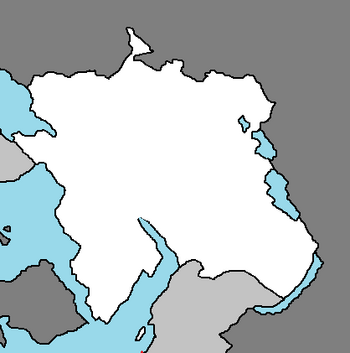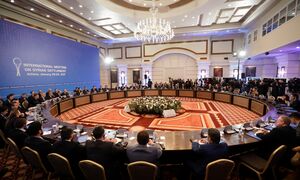Vuswistan
Federation of Vuswistan | |
|---|---|
|
Flag | |
 | |
| Capital | Tyrnatini |
| Official languages | Utobanian |
| Demonym(s) | Vuswistani |
| Government | |
| Panagiotakis Nicolalis | |
| Establishment | |
• Independence | 31 May 1817 |
• Current constitution | 31 May 1961 |
| Population | |
• 2020 estimate | 29,743,000 |
| Currency | Resmian |
| Date format | mm-dd-yyyy |
The Federation of Vuswistan, most commonly known as Vuswistan, is a nation in the Coalition of Crown Albatross located on the continent of Nortua, bordered by North Sotoa, North Icadania, New Anea, and Utobania, with a small maritime border with Syraranto. The capital is Tyrnatini, and the largest city is Timansi. About 80% of Vuswistanis are of Utobanian ancestry, divided among a variety of ethnic groups speaking different Nortuan languages. The remaining population consists of Nortua's largest communities of Adulan, Euronian, and multiracial ancestry.
Vuswistan was once a nation composed of multiple autonomous kingdoms. In the 1500s, the Constantio Empire conquered Vuswistan in the Arendia Conquests. Following victory in the Vuswistan Revolutionary War in 1821, the kingdoms united under the Federation of Vuswistan and organized under a centralized government. Today, Vuswistan is a member state of several international organizations such as the Coalition of Crown Albatross and the Sotoan Basin Union. It is currently headed by President Panagiotakis Nicolalis, and is largely considered to be a middle power in global affairs.
History
Prehistory
The area known as Vuswistan today was inhabited throughout the prehistoric period. Fossils of Neanderthals dating to the middle Palaeolithic period have been unearthed in northern Vuswistan, with the most famous and the best presented site in V'rapina. Remnants of several Neolithic and Chalcolithic cultures were found in all regions of the country. The largest proportion of the sites is in the river valleys of northern Vuswistan, and the most significant cultures whose presence was discovered include Baden, Starčevo, and Vučedol cultures. The Iron Age left traces of the early Vustatt culture and the Vetène culture.
Antiquity
Much later, the region was settled by Utobanians and Sotoans, while the first Syrarantoan colonies were established on the hills of Kvar, Vorčula, and Vis. In 9 AD the territory of today's Vuswistan became part of the Utobanian Empire. Emperor Viocletian was native to the region, and he had a large palace built in Tyrnatini to which he retired after his abdication in AD 305.
During the 5th century, the last de jure Emperor Julius Upos ruled his small realm from the palace after fleeing Utobania to go into exile in 475. The period ends with Sotoan and Vuswistanian invasions in the first half of the 7th century and the destruction of almost all Utobanian towns. Utobanian survivors retreated to more favourable sites on the coast, islands and mountains. The city of Tyrnatini was founded by such survivors from Epidaurum.
Middle Ages
Constantio Empire (1522-1821)
Vuswistan was conquered by the forces of the Constantio Empire over a series of battles against the native kingdoms during the Arendia Conquests.
Various provinces of the Vuswistan territories declared self-governance from Constantio in 1817. Constantio occupying forces cracked down on protestors and the ensuing rebellion sparked the Vuswistan Revolutionary War. Vuswistanian allied forces won the conflict and gained independence from the Constantio Empire on the 31st of May, 1821.
Modern Day
In May 2011, riots left over 60 people dead. The government estimated that over 50,000 people were driven from their homes. The targets were mainly legal and illegal migrants and refugees seeking asylum, but a third of the victims were Vuswistani citizens. In a 2014 survey, the Vuswistan Migration Project concluded that Vuswistanis are more opposed to immigration than any other national group. The Coalition of Crown Albatross High Commissioner for Refugees in 2008 reported over 200,000 refugees applied for asylum in Vuswistan, almost four times as many as the year before. These people were mainly from North Sotoa, though many also come from Siniapore, Yubonia, New Anea, and Kyti. Competition over jobs, business opportunities, public services and housing has led to tension between refugees and host communities. While xenophobia in Vuswistan is still a problem, recent violence has not been as widespread as initially feared. Nevertheless, as Vuswistan continues to grapple with racial issues, one of the proposed solutions has been to pass legislation, such as the pending Hate Crimes and Hate Speech Bill, to uphold Vuswistan's ban on racism and commitment to equality.
In 2020, following the outbreak of the Second Syraranto Civil War, nine members of the Sotoan Basin Union (Vuswistan, Constantio, South Sotoa, Utobania, Yubonia, New Anea, Siniapore, Karabakhi, and North Icadania) attended a summit hosted by Vuswistan President Panagiotakis Nicolalis in Tyrnatini, where leaders of the nine countries said they were ready to back CCA sanctions against Syraranto if Covijo shunned dialogue. Constantio underlined the prospect of sanctions earlier on Thursday, with Prime Minister Tony Blanian saying in an opinion piece that "If Syraranto refuses to see sense ... I see no option but for my fellow Sotoan Basin leaders to impose meaningful sanctions. Because this is no longer just about Nortuan solidarity. It is about recognising that vital interests - strategic CCA interests - are now at stake. If the CCA wants to exercise true geopolitical power, it simply cannot afford to appease a belligerent Syraranto."
On October 7th, 2020, delegates from regional countries and observer nations gathered in Tyrnatini, Vuswistan, for the Tyrnatini I Peace Talks. The aim of the C.C.A.-backed talks were to find a discernable peace settlement between the Syraranto government and the rebel forces. Civilian casualties had reached over 30,000 dead by October, making the war one of the most devastating modern conflicts for the rate of casualties among civilians. The Tasoulas government refused early in the talks to suspend bombing campaigns, and the talks quickly collapsed into governments working to damage the economic and fighting ability of the Tasoulas regime without being directly involved. Delegates largely agreed to suspend trade and diplomatic relations fully with Syraranto, while the C.C.A. suspended Syraranto and Great Epsilon's seats indefinitely or until Tasoulas stepped down from office and ended the military campaign. At this stage, De Yuan's Xi Jingyi decided to end their support of the Tasoulas government at the risk of sanctions.
Geography
Vuswistan is located in Central Nortua, on the coast of the Sotoa Sea. It borders Utobania and New Anea to the east, North Sotoa to the south, Syraranto via a maritime border to the west, and North Icadania by land to the west.
The territory covers 156,594 square kilometres (121,851 square miles), consisting of 156,414 square kilometres (121,782 square miles) of land and 328 square kilometres (249 square miles) of water. Elevation ranges from the mountains of the Vinaric Alps with the highest point of the Vinara peak at 1,831 metres (6,007 feet) near the border with Utobania to the shore of the Sotoa Sea which makes up its entire southwest border. Insular Vuswistan consists of over a thousand islands and islets varying in size, 48 of which are permanently inhabited. The largest islands are Cres and Krk, each of them having an area of around 405 square kilometres (156 square miles).
Demographics
Religion
Language
Cities
Politics





